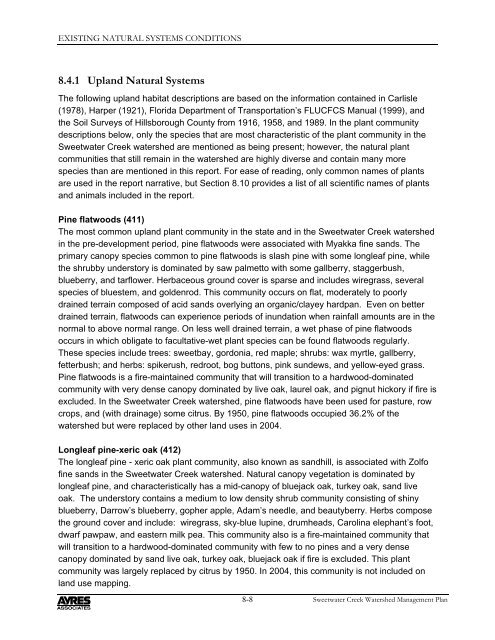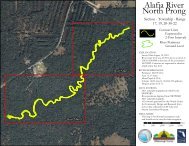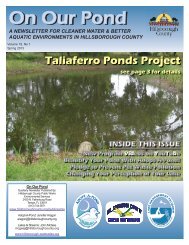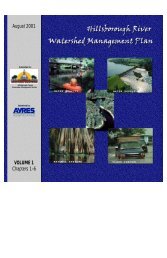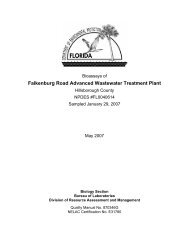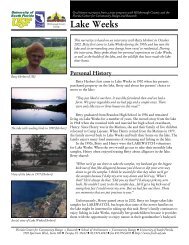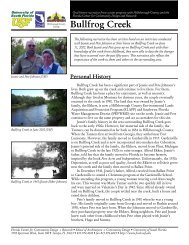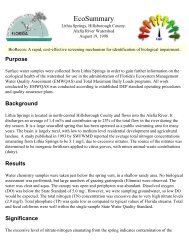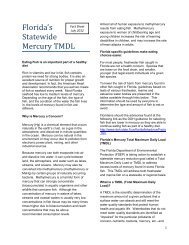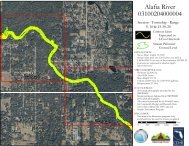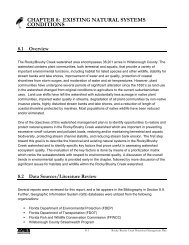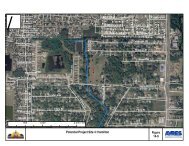Sweetwater Creek Watershed Mgmt. Plan 2007 Update--Part 2
Sweetwater Creek Watershed Mgmt. Plan 2007 Update--Part 2
Sweetwater Creek Watershed Mgmt. Plan 2007 Update--Part 2
You also want an ePaper? Increase the reach of your titles
YUMPU automatically turns print PDFs into web optimized ePapers that Google loves.
EXISTING NATURAL SYSTEMS CONDITIONS<br />
8.4.1 Upland Natural Systems<br />
The following upland habitat descriptions are based on the information contained in Carlisle<br />
(1978), Harper (1921), Florida Department of Transportation’s FLUCFCS Manual (1999), and<br />
the Soil Surveys of Hillsborough County from 1916, 1958, and 1989. In the plant community<br />
descriptions below, only the species that are most characteristic of the plant community in the<br />
<strong>Sweetwater</strong> <strong>Creek</strong> watershed are mentioned as being present; however, the natural plant<br />
communities that still remain in the watershed are highly diverse and contain many more<br />
species than are mentioned in this report. For ease of reading, only common names of plants<br />
are used in the report narrative, but Section 8.10 provides a list of all scientific names of plants<br />
and animals included in the report.<br />
Pine flatwoods (411)<br />
The most common upland plant community in the state and in the <strong>Sweetwater</strong> <strong>Creek</strong> watershed<br />
in the pre-development period, pine flatwoods were associated with Myakka fine sands. The<br />
primary canopy species common to pine flatwoods is slash pine with some longleaf pine, while<br />
the shrubby understory is dominated by saw palmetto with some gallberry, staggerbush,<br />
blueberry, and tarflower. Herbaceous ground cover is sparse and includes wiregrass, several<br />
species of bluestem, and goldenrod. This community occurs on flat, moderately to poorly<br />
drained terrain composed of acid sands overlying an organic/clayey hardpan. Even on better<br />
drained terrain, flatwoods can experience periods of inundation when rainfall amounts are in the<br />
normal to above normal range. On less well drained terrain, a wet phase of pine flatwoods<br />
occurs in which obligate to facultative-wet plant species can be found flatwoods regularly.<br />
These species include trees: sweetbay, gordonia, red maple; shrubs: wax myrtle, gallberry,<br />
fetterbush; and herbs: spikerush, redroot, bog buttons, pink sundews, and yellow-eyed grass.<br />
Pine flatwoods is a fire-maintained community that will transition to a hardwood-dominated<br />
community with very dense canopy dominated by live oak, laurel oak, and pignut hickory if fire is<br />
excluded. In the <strong>Sweetwater</strong> <strong>Creek</strong> watershed, pine flatwoods have been used for pasture, row<br />
crops, and (with drainage) some citrus. By 1950, pine flatwoods occupied 36.2% of the<br />
watershed but were replaced by other land uses in 2004.<br />
Longleaf pine-xeric oak (412)<br />
The longleaf pine - xeric oak plant community, also known as sandhill, is associated with Zolfo<br />
fine sands in the <strong>Sweetwater</strong> <strong>Creek</strong> watershed. Natural canopy vegetation is dominated by<br />
longleaf pine, and characteristically has a mid-canopy of bluejack oak, turkey oak, sand live<br />
oak. The understory contains a medium to low density shrub community consisting of shiny<br />
blueberry, Darrow’s blueberry, gopher apple, Adam’s needle, and beautyberry. Herbs compose<br />
the ground cover and include: wiregrass, sky-blue lupine, drumheads, Carolina elephant’s foot,<br />
dwarf pawpaw, and eastern milk pea. This community also is a fire-maintained community that<br />
will transition to a hardwood-dominated community with few to no pines and a very dense<br />
canopy dominated by sand live oak, turkey oak, bluejack oak if fire is excluded. This plant<br />
community was largely replaced by citrus by 1950. In 2004, this community is not included on<br />
land use mapping.<br />
8-8<br />
<strong>Sweetwater</strong> <strong>Creek</strong> <strong>Watershed</strong> Management <strong>Plan</strong>


